Efficient warehouse management is crucial for the success of any business that deals with physical goods. In today’s fast-paced and competitive market, warehouse managers need the right tools to streamline operations, improve accuracy, and enhance overall productivity. From inventory tracking to order fulfillment, the modern warehouse demands a sophisticated set of tools to stay ahead of the curve. In this article, we will explore the top 10 essential tools that every warehouse manager should consider integrating into their operations.
Warehouse Management System (WMS):
At the core of every successful warehouse operation is a robust Warehouse Management System (WMS). This software solution optimizes daily tasks such as inventory tracking, order processing, and shipping management. A WMS not only enhances efficiency but also provides real-time visibility into inventory levels, helping warehouse managers make informed decisions.
Barcode Scanners:
Barcode scanners are indispensable tools for warehouse managers aiming to improve accuracy and reduce errors in the inventory management process. These devices allow for quick and precise tracking of items throughout the warehouse, from receiving to shipping. Barcode scanners integrate seamlessly with WMS, enhancing data accuracy and minimizing manual entry errors.
RFID Technology:
Radio-Frequency Identification (RFID) technology is a powerful tool for warehouse managers looking to automate and streamline their inventory management processes further. RFID tags can be attached to products, pallets, or containers, enabling real-time tracking and providing accurate data on the location and movement of items within the warehouse. This technology is particularly useful for high-volume and fast-moving goods.
Automated Guided Vehicles (AGVs):
In large warehouses with high volumes of goods to move, AGVs offer a game-changing solution. These autonomous vehicles can transport goods within the warehouse without human intervention. AGVs increase efficiency, reduce labor costs, and minimize the risk of errors associated with manual material handling. Integrating AGVs into warehouse operations can lead to a significant boost in productivity.
Cloud-Based Inventory Management:
Cloud-based inventory management systems provide warehouse managers with the flexibility to access real-time data from anywhere. This tool allows for efficient collaboration among team members, regardless of their physical location. Additionally, cloud-based systems offer scalability and eliminate the need for extensive on-site IT infrastructure, making them a cost-effective solution for businesses of all sizes.

Pallet Jacks
Pallet jacks, or pallet trucks, are indispensable for material handling tasks within the warehouse. These manually operated or electric-powered devices allow for the easy and efficient movement of palletized goods, especially in environments where forklifts may be impractical. Pallet jacks enhance the agility of warehouse operations, enabling workers to quickly transport goods from storage to the shipping area or between various sections of the warehouse. Their simplicity, coupled with the ability to handle heavy loads, makes pallet jacks a must-have tool for warehouse managers looking to optimize material handling processes and maintain a smooth workflow.
Demand Forecasting Software:
Accurate demand forecasting is crucial for optimizing inventory levels and preventing stockouts or overstock situations. Demand forecasting software utilizes historical data, market trends, and other factors to predict future demand for products. Warehouse managers can use this information to adjust inventory levels and ensure that products are available when customers need them, ultimately improving customer satisfaction.
Pick-to-Light Systems:
Pick-to-Light systems are valuable tools for warehouse managers looking to improve order picking accuracy and speed. These systems use light displays to guide warehouse workers to the exact location of items on a pick list. By reducing the chances of picking errors, pick-to-light systems contribute to higher order fulfillment accuracy and improved overall efficiency in the warehouse.
Mobile Device Management (MDM):
With the increasing use of smartphones and tablets in the workplace, warehouse managers can leverage Mobile Device Management (MDM) solutions to ensure the security and efficiency of mobile devices used by their teams. MDM tools enable centralized management of devices, ensuring that they are properly configured, secure, and updated, thereby enhancing communication and data access within the warehouse.
Collaborative Robotics (Cobots):
Collaborative robots, or cobots, are designed to work alongside human employees to automate repetitive and labor-intensive tasks. In warehouses, cobots can assist with tasks such as packing, sorting, and palletizing. By integrating cobots into the workforce, warehouse managers can increase efficiency, reduce the risk of injuries, and allocate human resources to more complex and strategic roles.
Performance Analytics and Reporting Tools:
To continuously improve warehouse operations, managers need insights into key performance indicators (KPIs). Performance analytics and reporting tools provide valuable data on metrics such as order fulfillment times, inventory turnover rates, and labor productivity. Armed with this information, warehouse managers can identify areas for improvement, optimize processes, and make data-driven decisions to enhance overall performance.
In the dynamic and competitive landscape of modern business, warehouse managers must leverage technology to stay ahead of the curve. The integration of these essential tools, from advanced software solutions to robotics and analytics, is paramount for optimizing warehouse operations. By adopting these tools, warehouse managers can enhance accuracy, improve efficiency, and ultimately contribute to the success and growth of their businesses in the long run.
Are these tools only suitable for large-scale warehouses, or can they be applied to smaller operations as well?
Absolutely! While some tools like Automated Guided Vehicles (AGVs) may be more common in large warehouses due to their scale, many others, such as barcode scanners, cloud-based inventory management, and pallet jacks, are highly adaptable to smaller operations. In fact, implementing these tools in smaller warehouses can bring about significant efficiency gains and process improvements.
Can pallet jacks be operated by one person, and are they easy to use?
Yes, a pallet jack is designed for single-person operation and are known for their user-friendly nature. Minimal training is required for efficient use in warehouse operations.
Are these tools only relevant for certain industries, or can they be applied across various sectors?
The tools discussed in the article are designed to be versatile and can be applied across a wide range of industries. Whether a warehouse is dealing with retail, manufacturing, e-commerce, or distribution, the principles of efficient inventory management, order fulfillment, and material handling remain consistent. Businesses from various sectors can tailor the implementation of these tools to suit their specific needs.
How can these tools contribute to sustainability and environmentally friendly warehouse practices?
Implementing these tools can contribute significantly to sustainability efforts. For instance, Automated Guided Vehicles (AGVs) and Collaborative Robots (Cobots) can optimize energy consumption and reduce the need for traditional forklifts, which are often less energy-efficient. Additionally, accurate demand forecasting and inventory management tools help minimize overstock situations, reducing unnecessary waste.
What kind of budget should warehouse managers allocate for adopting these tools?
The budget required depends on the scale of the warehouse, the specific tools chosen, and the extent of integration needed. While some tools, like barcode scanners and pallet jacks, are relatively cost-effective, more advanced technologies such as AGVs and Collaborative Robots may require a more substantial investment. Warehouse managers should conduct a thorough cost-benefit analysis to determine the most suitable tools for their budget and operational requirements.

